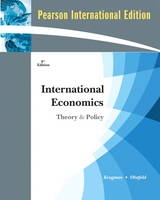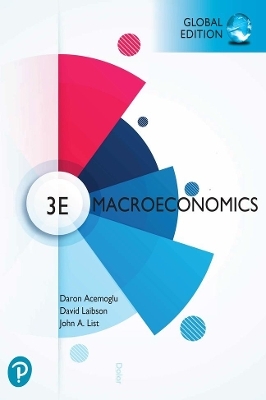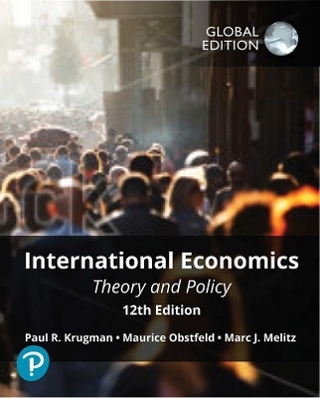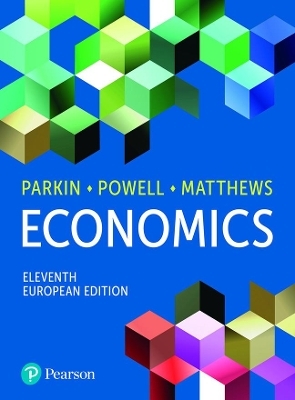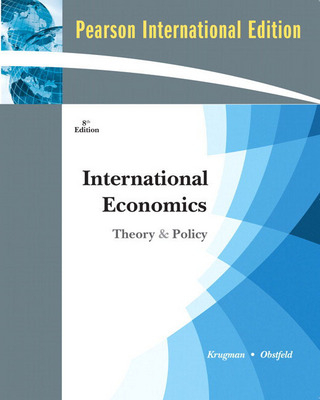
International Economics:Theory and Policy: International Edition with MyEconLab in CourseCompass plus eBook Student Access Kit
Pearson Education Limited
978-1-4082-0807-6 (ISBN)
- Titel erscheint in neuer Auflage
- Artikel merken
Chapter 1. Introduction What Is International Economics About? International Economics: Trade and Money Part I. International Trade Theory Chapter 2. World Trade: An Overview Who Trades with Whom? The Changing Pattern of World Trade Do Old Rules Still Apply? Chapter 3. Labor Productivity and Comparative Advantage: The Ricardian Model The Concept of Comparative Advantage A One-Factor Economy Trade in a One-Factor World Misconceptions About Comparative Advantage Comparative Advantage with Many Goods Adding Transport Costs and Nontraded Goods Empirical Evidence on the Ricardian Model Chapter 4. Resources, Comparative Advantage, and Income Distribution A Model of a Two-Factor Economy Effects of International Trade Between Two-Factor Economies The Political Economy of Trade: A Preliminary View Empirical Evidence on the Heckscher-Ohlin Model Appendix: Factor Prices, Goods Prices, and Input Choices Chapter 5. The Standard Trade Model A Standard Model of a Trading Economy International Transfers of Income: Shifting of the RD Curve Tariffs and Export Subsidies: Simultaneous Shifts in RS and RD Appendix: Representing International Equilibrium with Other Curves Chapter 6. Economies of Scale, Imperfect Competition, and International Trade Economies of Scale and International Trade: An Overview Economies of Scale and Market Structure The Theory of Imperfect Competition Monopolistic Competition and Trade Dumping The Theory of External Economies External Economies and International Trade Economic Geography and Interregional Trade Appendix: Determining Marginal Revenue Chapter 7. International Factor Movements International Labor Mobility International Borrowing and Lending Direct Foreign Investment and Multinational Firms Appendix 1: Finding Total Output from the Marginal Product Curve Appendix 2: More on Intertemporal Trade Part II. International Trade Policy Chapter 8. The Instruments of Trade Policy Basic Tariff Analysis Costs and Benefits of a Tariff Other Instruments of Trade Policy The Effects of Trade Policy: A Summary Appendix 1: Tariff Analysis in General Equilibrium Appendix 2: Tariffs and Import Quotas in the Presence of Monopoly Chapter 9. The Political Economy of Trade Policy The Case for Free Trade National Welfare Arguments Against Free Trade Income Distribution and Trade Policy International Negotiations and Trade Policy The Doha Disappointment Appendix: Proving That the Optimum Tariff Is Positive Chapter 10. Trade Policy in Developing Countries Import-Substituting Industrialization Results of Favoring Manufacturing: Problems of Import-Substituting Industrialization Trade Liberalization Since 1985 Export-Oriented Industrialization: The East Asian Miracle Chapter 11. Controversies in Trade Policy Sophisticated Arguments for Activist Trade Policy Globalization and Low-Wage Labor Globalization and the Environment Part III. Exchange Rates and Open-Economy Macroeconomics Chapter 12. National Income Accounting and the Balance of Payments The National Income Accounts National Income Accounting for an Open Economy The Balance of Payments Accounts Chapter 13. Exchange Rates and the Foreign Exchange Market: An Asset Approach Exchange Rates and International Transactions The Foreign Exchange Market The Demand for Foreign Currency Assets Equilibrium in the Foreign Exchange Market Interest Rates, Expectations, and Equilibrium Appendix: Forward Exchange Rates and Covered Interest Parity Chapter 14. Money, Interest Rates, and Exchange Rates Money Defined: A Brief Review The Demand for Money by Individuals Aggregate Money Demand The Equilibrium Interest Rate: The Interaction of Money Supply and Demand The Money Supply and the Exchange Rate in the Short Run Money, the Price Level, and the Exchange Rate in the Long Run Inflation and Exchange Rate Dynamics Chapter 15. Price Levels and the Exchange Rate in the Long Run The Law of One Price Purchasing Power Parity A Long-Run Exchange Rate Model Based on PPP Empirical Evidence on PPP and the Law of One Price Explaining the Problems with PPP Beyond Purchasing Power Parity: A General Model of Long-Run Exchange Rates International Interest Rate Differences and the Real Exchange Rate Real Interest Parity Appendix: The Fisher Effect, the Interest Rate, and the Exchange Rate Under the Flexible-Price Monetary Approach Chapter 16. Output and the Exchange Rate in the Short Run Determinants of Aggregate Demand in an Open Economy The Equation of Aggregate Demand How Output Is Determined in the Short Run Output Market Equilibrium in the Short Run: The DD Schedule Asset Market Equilibrium in the Short Run: The AA Schedule Short-Run Equilibrium for an Open Economy: Putting the DD and AA Schedules Together Temporary Changes in Monetary and Fiscal Policy Inflation Bias and Other Problems of Policy Formulation Permanent Shifts in Monetary and Fiscal Policy Macroeconomic Policies and the Current Account Gradual Trade Flow Adjustments and Current Account Dynamics Appendix 1: Intertemporal Trade and Consumption Demand Appendix 2: The Marhsall-Lerner Condition and Empirical Estimates of Trade Elasticities Chapter 17. Fixed Exchange Rates and Foreign Exchange Intervention Why Study Fixed Exchange Rates? Central Bank Intervention and the Money Supply How the Central Bank Fixes the Exchange Rate Stabilization Policies with a Fixed Exchange Rate Balance of Payments Crises and Capital Flight Managed Floating and Sterilized Intervention Reserve Currencies in the World Monetary System The Gold Standard Appendix 1: Equilibrium in the Foreign Exchange Market with Imperfect Asset Substitutability Appendix 2: The Timing of Balance of Payments Crises Part IV. International Macroeconomic Policy Chapter 18. The International Monetary System, 1870 1973 The Interwar Years, 1918 1939 The Bretton Woods System and the International Monetary Fund Analyzing Policy Options Under the Bretton Woods System The External Balance Problem of the United States Worldwide Inflation and the Transition to Floating Rates Chapter 19. Macroeconomic Policy and Coordination Under Floating Exchange Rates The Case for Floating Exchange Rates The Case Against Floating Exchange Rates Macroeconomic Interdependence Under a Floating Rate What Has Been Learned Since 1973? Are Fixed Exchange Rates Even an Option for Most Countries? Directions for Reform Appendix: International Policy Coordination Failures Chapter 20. Optimum Currency Areas and the European Experience How the European Single Currency Evolved The Euro and Economic Policy in the Euro Zone The Theory of Optimum Currency Areas The Future of EMU Chapter 21. The Global Capital Market: Performance and Policy Problems The International Capital Market and the Gains from Trade International Banking and the International Capital Market Regulating International Banking Chapter 22. Developing Countries: Growth, Crisis, and Reform Income, Wealth, and Growth in the World Economy Structural Features of Developing Countries Developing-Country Borrowing and Debt East Asia: Success and Crisis Lessons of Developing-Country Crises Reforming's Financial Architecture Understanding Global Capital Flows and the Global Distribution of Income: Is Geography Destiny? Mathematical Postscripts
| Erscheint lt. Verlag | 3.7.2008 |
|---|---|
| Verlagsort | Harlow |
| Sprache | englisch |
| Maße | 212 x 254 mm |
| Gewicht | 1350 g |
| Themenwelt | Wirtschaft ► Volkswirtschaftslehre ► Makroökonomie |
| ISBN-10 | 1-4082-0807-5 / 1408208075 |
| ISBN-13 | 978-1-4082-0807-6 / 9781408208076 |
| Zustand | Neuware |
| Haben Sie eine Frage zum Produkt? |
aus dem Bereich
